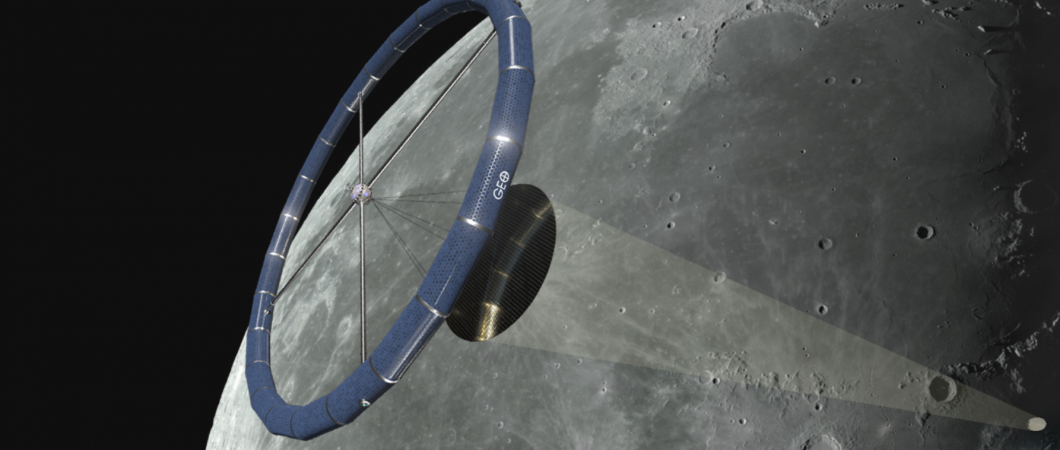Andreas Vogler Studio is participating in a study conducted by the Swiss enterprise Astrostrom GmbH. Astrostrom was awarded a study contract last year from the European Space Agency (ESA) to investigate the potential of building Space Power Satellites (SPS) with lunar resources and transfer them into Earth orbit to send clean solar energy down to Earth.
Astrostrom GmbH is a Swiss company run the space entrepreneur and artist Arthur Woods. Already last year Astrostrom pointed out the „Energy Dilemma“ of Switzerland and proposed Space-based Solar Power (SBSP) as ‚a space option‘ to deliver carbon-neutral solar energy also during the night and cloudy skies. Switzerland has like many other states pledged to opt out of fossil energy and also of nuclear energy by the year 2050, leaving a big gap to fill with renewables.
One of the big hurdles for space power satellites built on Earth is their huge dimensions of several kilometers, which requires a large number of rocket launches to place these into orbit. The Greater Earth Lunar Power Station (GE⊕-LPS) study is thus proposing to minimize the number of rocket launches needed from Earth to place a SPS into orbit by building them on the Moon. The elements of the GE⊕-LPS would be constructed primarily from lunar resources using a lunar-based automatized manufacturing process connected to a mass driver system or lunar space elevator for transport into a lunar orbit. Earth-Moon Lagrange Point L1 would be an appropriate assembly point. The toroidal design allows for the central placement of a habitat and control center that uses water and lunacrete for radiation shielding. The GE⊕-LPS is a SPS concept that incorporates both technological and economical approaches with a possible lunar tourist destination to create further sources of funding.
Once the robot-driven industrial production on the Moon is established, more SPSs can be built and transferred to Earth orbits.
The GE⊕-LPS has two practical objectives:
it is an optimized technical approach to economically realizing SBSP as a means to address the energy dilemma and climate emergency issues on Earth, and,
it provides an inspiring and purposeful facility for developing humanity’s lunar aspirations.
The idea of SBPS goes back to the 1960’s and the oil crisis of the 1970’s. However, the past decade has provided all necessary ingredients: fast declining launch costs, accelerating development in robotics and AI, the Fukushima nuclear accident, global warming and over 100 nations committing to carbon neutrality by 2050. On December 9 and 10, 2021 the European Space Agency ESA held an international workshop entitled „Space-based Solar Power for Net Zero“. Participants were mainly from UK, USA, Japan and China, all nations with active R&D programmes for SBSP. It became clear, that SBSP is no longer science-fiction, but a valid option to contribute to the planet’s green energy needs. But the development must be started now.
The study team consists of:
Arthur R. Woods, space entrepreneur and artist, who has two art-in-space projects successfully flown on the Russian Mir space station: the Cosmic Dancer sculpture in 1993 and Ars Ad Astra: The First Art Exhibition in Earth Orbit in 1995 during the EuroMir95 mission.
Dr. Marco C. Bernasconi a Swiss expert in lightweight space structures, astronautical systems, and astronautics and society assessments. During his career he gained extensive experience in the development of ultralight structure technologies and application designs.
Dr. Patrick Collins, a British expert on space solar power and space tourism currently residing in Japan. He is chairman of the Society for Space Tourism of Japan (SSTJ) and Emeritus Professor of Azabu University, where he taught economics for 19 years
Andreas Vogler, a Swiss architect and designer based in Munich, Germany. He has a long experience in space habitat design, having worked on furniture equipment for the ISS, habitat and rover designs for Moon and Mars. He also has flown the sculpture AtlasCoelestisZeroG on the International Space Station ISS.
Théotime Coudray, a French Ph.D. candidate in energy economics working at University of Montpellier (ART-Dev laboratory) and Climate Economics Chair (Paris). He is specialized in renewables energies, smart power systems, electricity storage and has a strong interest in space activities, particularly energy from space.
Dmitrijis Gasperovics, resides in Latvia and is a specialist in computer 3D animation and video realization and Fluid Simulations with a dedicated interest in space technology visualizations.
Andreas Vogler Studio is working with the team to define and design the habitat requirements and the building materials.
We appreciate your coverage and are available for any queries, please contact:
Andreas Vogler Studio – Public Relations
E-Mail: av@andreasvogler.com
Tel: +49 173 3570833, Web: www.andreasvogler.com
The Munich based architecture and design office AV Studio led by Swiss architect Andreas Vogler works on international projects for the society of today and the world of tomorrow. With experienced partners and an interdisciplinary team. Between the poles of the core competencies of architecture, art, design and aerospace AV Studio explores the potential of the future.
More about Andreas Vogler Studio and its projects: www.andreasvogler.com
Photos
The use of images is free of charge naming Astrostrom GmbH as credit.
On request, we can provide you with further images and video material available.

